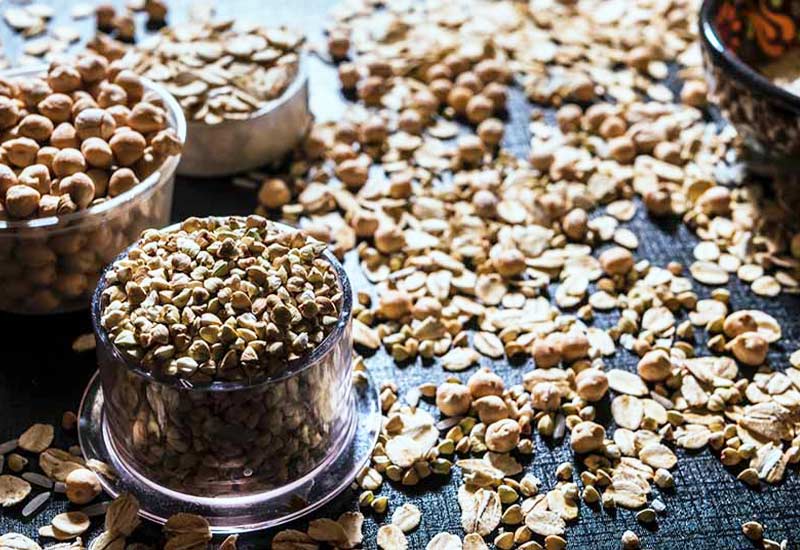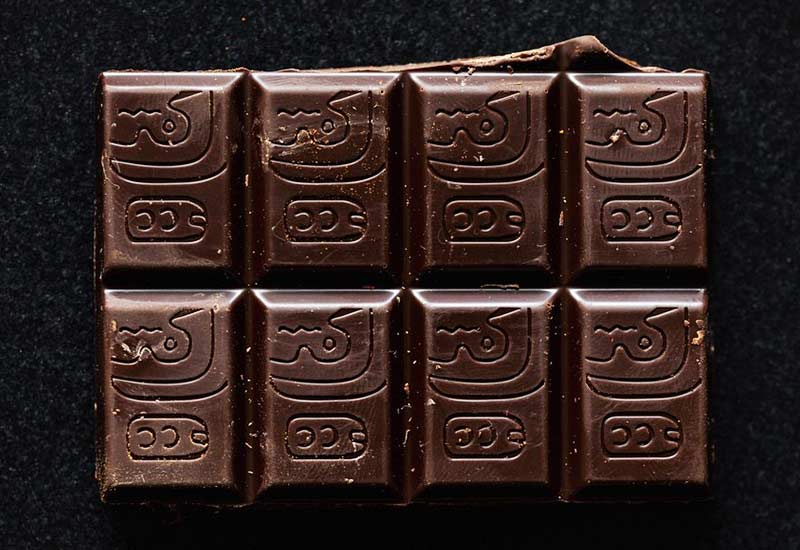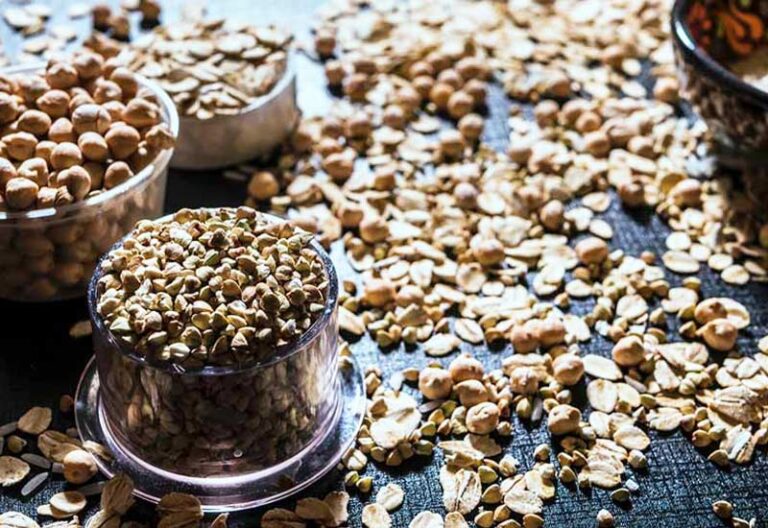Are you looking for information about the trace element copper? Then you can now sit back and relax and read the following article! Here you will find everything you need to know about the essential nutrient. At the beginning, I summarize the basics in a fact sheet. Afterwards, I will provide you with valuable information on intake, daily requirement, physiological significance, risk of overdose or deficiency, as well as good sources of copper. In addition, towards the end I provide information for vegans and vegetarians, recommendations for dietary supplements and answers to frequently asked questions.
Here is in advance a Overview for you:
Notice: This article is not a substitute for medical advice, but only provides general information about copper. Please consult your doctor if you feel unwell or want to prevent health problems with medical care.
Copper PROFILE at a glance
Assignment: Essential trace element, element category transition metals
Important for: Metabolism, connective tissue, brain development, immune system
Daily requirement: 0.9-1.6 mg/day from the age of 19.1,2,3
Recording: by ingestion
Overdose: Maximum intake of 10 mg/day2,3,4,5
Deficiency symptoms: including anemia, immunodeficiency, disorders of energy and iron metabolism, enzyme processes3
Food: Cocoa powder, cashews, sunflower seeds, tahini6
Nutritional supplement: As capsules or tablets
How do you absorb copper?

Buckwheat flakes, oatmeal and hazelnuts, for example, are recommended foods rich in copper. The trace element is a vital mineral, which is needed in the body for many different processes. The nutrient is also water soluble and stable to light, heat and oxygen.
The trace element Zinc however, is an important antagonist in copper absorption and can inhibit it when high doses of zinc are taken.7 Copper absorption in young children appears to be affected by a high intake of Iron also to decline.8
What is the daily requirement?
According to the recommended daily intake of copper is German Nutrition Society (DGE) between 1.0 and 1.5 mg per day.1 The European Food Safety Authority (EFSA) differentiates its reference values according to gender, namely 1.3 mg for women and 1.6 mg for men.2 A slightly lower intake of 0.9 mg is reported by the National Institutes of Health (NIH) issued.3
For pregnant and breastfeeding women is used by the EFSA an increase in copper intake to 1.5 mg per day and from the NIH to 1.3 mg daily is recommended.2,3 From the DGE there is no indication in this respect.1
The following are the reference values of the DGE for Children and teenagers listed.
| Children and teenagers | Recommended intake in mg |
| 0 to under 4 months | 0,2-0,6 |
| 4 to under 12 months | 0,6-0,7 |
| 1 to under 7 years | 0,5-1,0 |
| from 7 years and older | 1,0-1,5 |
What is copper needed for?
The essential trace element fulfills a variety of tasks in the human body. Among other things, copper as a co-factor influences the Iron and energy metabolism and likewise the Synthesis of neurotransmitters. The skin also benefits from a healthy copper intake, as the trace element affects the Connective tissue synthesis and Pigmentation effects. Other important tasks are the Vascularization, gene expression and brain development.. Finally, the influence on the function of the Immune system mentioned.3
Important roles of copper in the body in the overview:
- Co-factor in the enzyme system
- Influence on energy metabolism
- Influence on iron metabolism
- Connective tissue synthesis
- Synthesis of neurotransmitters
- Vascularization
- Gene Expression
- Brain development
- Contribution to the immune system
Can copper be overdosed?
Basically, the trace element has a relatively low toxicity, which means that acute poisoning is Very unlikely is. Nevertheless, several nutrition societies have set a so-called Tolerable Upper Intake Level – i.e. a maximum intake – of 10 mg per day.2,3,4,5
A chronically increased copper intake can lead to Symptoms such as liver damage or digestive tract disorders. Risk group for such copper overdose are mainly patients with Wilson’s disease.2,3
When does the deficiency occur?
A copper deficiency is basically rather unlikely. People with a increased risk for copper deficiency are patients with Menkes syndrome, celiac disease, and people taking high-dose zinc supplements.
In this context, the deficiency of the vital trace element can be Symptoms such as anemia, hypopigmentation, connective tissue disorders, osteoporosis, disorders of the Fat-metabolism, hypercholesterolemia, as well as a disorder of movement coordination called ataxia and an increased risk of infections.2,3
What does copper contain?


Copper is found in a wide variety of foods. Among them are also many good Plant sourceswhich I recommend to you for ethical, health and ecological reasons:
- Cocoa powder (3.8 mg per 100 gram)
- Cashews (3.7 mg per 100 gram)
- Sunflower seeds (1.9 mg per 100 gram)
- Dark chocolate (1.8 mg per 100 gram)
- Spirulina (1.8 mg per 100 gram)
- Tahini (1.7 mg per 100 gram)
- Hazelnuts (1.6 mg per 100 gram)
- Buckwheat flour (0.9 mg per 100 gram)
What do vegans need to consider?
According to the DGE is Copper not a critical nutrient in plant-based lifestyles.9 This is due to the fact that there are many good plant sources of copper and thus vegans can easily meet their copper needs.
Do copper supplements have any benefit?
For most people, copper supplements are rather superfluous, as they get sufficient amounts of the trace element from their diet. If you belong to a risk group or do not feel well, it may be useful to consider supplementation. For this you should check your copper status in the Measure serum or whole blood let7
Since the metabolism of copper and zinc influence each other, I recommend always supplementing both trace elements if necessary. This way you can avoid having a deficit in the other nutrient.
Furthermore, I recommend with dietary supplements, if possible, to pay attention to a natural and vegetable origin. Just such a dietary supplement based on buckwheat germ are, for example. these capsules with zinc, copper and manganese*.
Copper FAQ: The most frequently asked questions
What makes copper deficiency?
Copper deficiency results in anemia, hypercholesterolemia, increased susceptibility to infections and ataxia, among other symptoms. However, a deficiency is very unlikely.
Which vegetables contain a lot of copper?
Vegetables high in cuper include kale, garlic, potatoes, ginger root and artichokes.
In which nuts is copper?
From the food category nuts and seeds, especially sesame, almonds, hazelnuts, cashews and sunflower seeds are known for a high copper content.
What happens when there is too much copper in the body?
Copper has a low toxicity and rarely leads to acute poisoning. However, liver damage or disturbances of the digestive tract may occur in risk groups.
Is copper good for the skin?
Since copper is involved in the synthesis of connective tissue and pigment formation, a healthy copper intake can also have a positive effect on the appearance of the skin.
A good supply of copper is uncomplicated
Most people are affected by a varied diet sufficiently supplied with the trace element copper. In certain exceptional cases, however, it can be useful to supplement copper additionally. So that you live as holistically healthy as possible and many Prevent diseases I recommend for example Forest bathing, Barefoot running or Intermittent fasting.
Feel free to leave me a comment with questions, criticisms, and other suggestions about copper.
All the best,


PS.: Many good tips for a conversion to vegan nutrition you can find in the article vegan life. If you want to know more about micronutrients, I recommend you read the articles on Zinc, Calcium or Vitamin A.
References:
1 Deutsche Gesellschaft für Ernährung e. V.: Copper, manganese, chromium, molybdenum, https://www.dge.de/wissenschaft/referenzwerte/kupfer-mangan-chrom-molybdaen/?L=0. [07.01.2022].
2 European Food Safety Authority: Scientific Opinion on Dietary References for copper, https://efsa.onlinelibrary.wiley.com/doi/epdf/10.2903/j.efsa.2015.4253. [07.01.2022].
3 National Institutes of Health. Office of Dietary Supplements: Copper. Fact Sheet for Health Professionals, https://ods.od.nih.gov/factsheets/Copper-HealthProfessional. [07.01.2022].
4 European Food Safety Authority: Tolerable Upper Intake Levels for Vitamins and Minerals, https://www.efsa.europa.eu/sites/default/files/efsa_rep/blobserver_assets/ndatolerableuil.pdf. [07.01.2022].
5 Bundesamt für Risikobewertung: Höchstmengenvorschläge für Kupfer inklusive Nahrungsergänzungsmitteln, https://www.bfr.bund.de/cm/343/hoechstmengenvorschlaege-fuer-kupfer-in-lebensmitteln-inklusive-nahrungsergaenzungsmitteln.pdf, [07.01.2022]. [07.01.2022].
6 Zentrum der Gesundheit: Gray hair may be caused by copper deficiency, https://www.zentrum-der-gesundheit.de/news/gesundheit/allgemein-gesundheit/graues-haar-durch-kupfermangel-180804077. [07.01.2022].
7 Center of health: Determine mineral deficiency: Diagnosis, https://www.zentrum-der-gesundheit.de/krankheiten/weitere-erkrankungen/mangelerscheinungen/mineralstoffmangel. [07.01.2022].
8 The National Academie Press (2009) Dietary Reference Intakes: The Essential Guide to Nutrient Requirements, https://www.nap.edu/catalog/11537/dietary-reference-intakes-the-essential-guide-to-nutrient-requirements. [07.01.2022].
9 Deutsche Gesellschaft für Ernährung e. V.: Supplement to the position of the German Nutrition Society regarding population groups with special nutritional needs, https://www.dge.de/wissenschaft/weitere-publikationen/dge-position/vegane-ernaehrung/?L=0 [07.01.2022].
